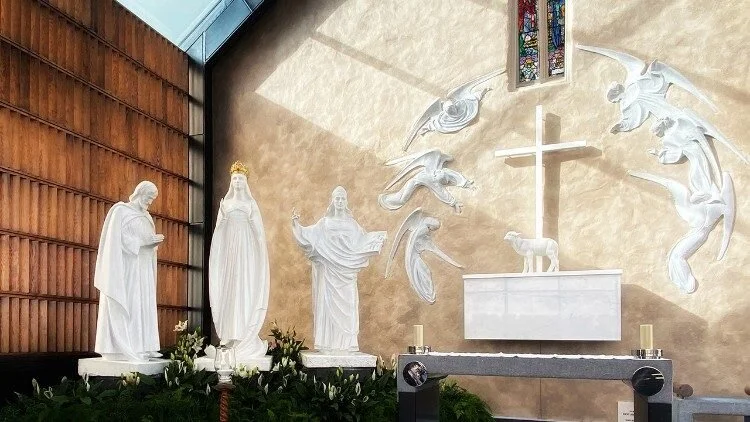On the 21st August 1879, Our Lady appeared to the people of Knock, Co. Mayo, Ireland. The country was facing a famine at that time, with Mayo one of the worst hit just as it had been during previous famines. 1879 also marked 50 years since the end of the Penal Laws in Ireland, which had forbidden Mass for centuries.
Unlike many other apparitions, Our Lady remained silent. Alongside her were St. John the Evangelist, St. Joseph and the image of the Lamb upon the altar. The locals who witnessed the event prayed for hours at the church after witnessing it.
Our Lady’s silence has been the subject of much debate, but perhaps it should remain so. Silence in prayer is always a sign of humility and reverence for the mysteriousness of our existence. If there is one thing that Ireland, and the world, needs now, it is that.
The witnesses to that event wrote down what they saw that day.
Here are a few of their statements in their own words:
PATRICK BYRNE
“I am sixteen years of age; I live quite near the chapel; I remember well the evening of the 21st August; it was Thursday, the evening before the Octave day. Dominick Byrne, junior, a namesake of mine, came to my house, and said that he had seen the biggest sight that ever he witnessed in his life. It was then after eight o’clock.
I came by the road on the west side of the church, I saw the figures clearly, fully, and distinctly, the Blessed Virgin, St. Joseph, and that of a bishop, said to be St. John the Evangelist. (Young Byrne then told what he saw regarding the vision, just as it has been described already by several persons who were present. The young fellow showed by his hands and position how the image or apparition of the Blessed Virgin Mary and that of St. Joseph and St. John stood). I remained only ten minutes, and then I went away. All this happened between a quarter or so past eight o‘clock and half past nine’’
DOMINICK BYRNE
“I am brother of Mary Byrne, who has given evidence already; I live near the chapel of Knock. My age is twenty years. On the occasion when my sister came about eight o’clock on the evening of the 21st August into our house, she exclaimed: ‘Come Dominick, and see the image of the Blessed Virgin, as she had appeared to us down at the chapel.’ I said: What image?” and then she told me, as she has already described it for your Reverence in her testimony; she told me all she was after seeing. I then went with her, and by this time some ten or twelve people had been collected around the place, namely, around the ditch or wall fronting the gable, where the vision had been seen, and to the south of the schoolhouse.
Then I beheld the three likenesses or figures that have been already described, The Blessed Virgin, St. Joseph, and St. John, as my sister called the bishop, who was like one preaching, with his hand raised towards the shoulder, and the forefinger and middle finger pointedly set, the other two fingers compressed by the thumb; in his left hand he held a book; he was so turned that he looked half towards the altar and half towards the people. The eyes of the images could be seen; they were like figures, inasmuch as they did not speak. I was filled with wonder at the sight I saw; I was so affected that I shed tears. I continued looking on for fully an hour, and then I went away to visit Mrs. Campbell, who was in a dying state; When we returned the vision had disappeared’’
MARGARET BYRNE (WIDOW)
“I, Margaret Byrne, nee Bourke, widow of Dominick Byrne, deceased, live near the chapel at Knock. I remember the evening of the 21st August. I was called out at about a quarter past eight o’clock by my daughter Margaret to see the vision of the Blessed Virgin Mary, and of the saints who appeared at the end of the little church. It was getting dark; it was raining. I came with others to the wall opposite the gable. I saw then and there distinctly the three images, one of the Blessed Virgin Mary, one of St. Joseph, and the third, as I learned, that of St. John the Evangelist.
I saw an altar, too, and a lamb on it somewhat whiter than the altar; I did not see the cross on the altar. The Blessed Virgin Mary appeared in the attitude of prayer, with her eyes turned up towards heaven, a crown on her head, and an outer garment thrown around her shoulders. I saw her feet. St. Joseph appeared turned towards the Blessed Virgin, with head inclined. I remained looking on for fully fifteen or twenty minutes; then I left and returned to my own house’’
JUDITH CAMPBELL
“I live at Knock, I remember the evening and night of the 21 August last. Mary Byrne called at my house about eight o’clock on that evening, and asked me to come up and see the great sight at the chapel. I ran up with her to the place, and I saw outside the chapel, at the gable of the sacristy facing the south, three figures representing St. Joseph, St. John and the Blessed Virgin Mary, also an altar, and the likeness of a lamb on it, with a cross at the back of the lamb. I saw a most beautiful crown on the brow or head of the Blessed Virgin. Our Lady was in the centre of the group, a small height above the other two; St. Joseph, St. John and the Blessed Virgin Mary, also an altar, and the likeness of a lamb on it, with a cross at the back of the lamb. I saw a most beautiful crown on the brow or head of the Blessed Virgin. Our Lady was in the centre of the group, a small height above the other two, St. Joseph to her right, and bent towards the Virgin, St. John, as we were led to call the third figure, was to the left of the Virgin, and in his left hand he held a book, his right hand was raised with the first and second fingers closed, and the forefinger and middle finger extended as if he were teaching. The night came on, and it was very wet and dark.
There was a beautiful light shining around the figures or likenesses that we saw. I went within a foot of them, none of us spoke to them, we believed they were St. Joseph and St. John the Evangelist, because some years ago, statues of St Joseph and of the Evangelist were in the chapel in Knock. All the figures were in white or in a robe of sliver-like whiteness, St. John wore a small mitre. Though it was raining, the place in which the figures appeared was quite dry.”



